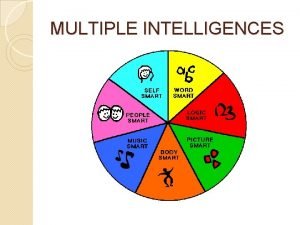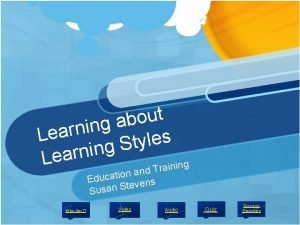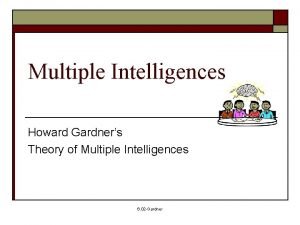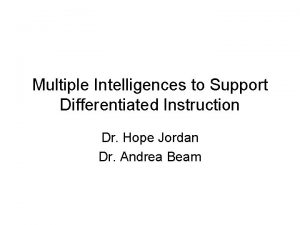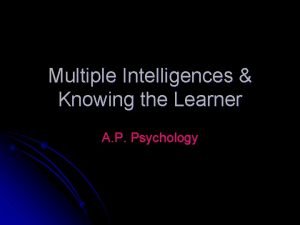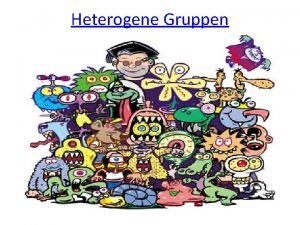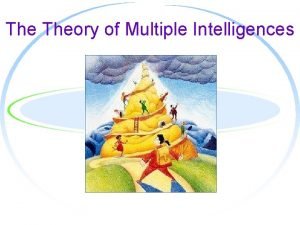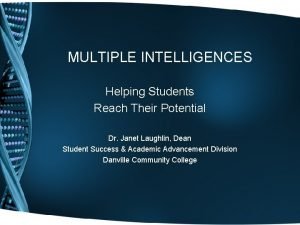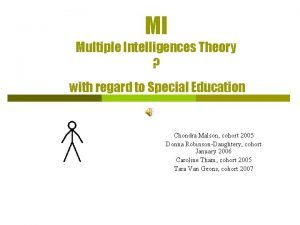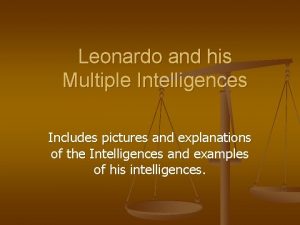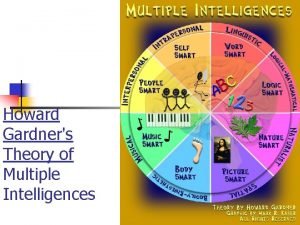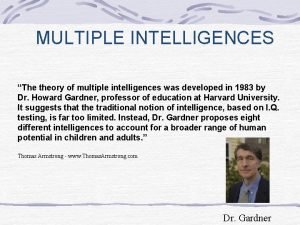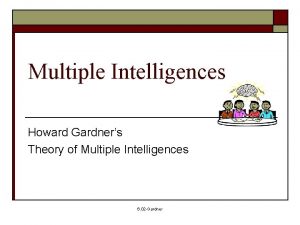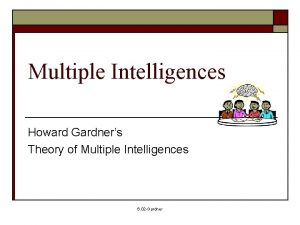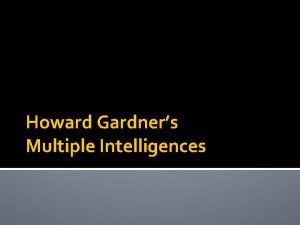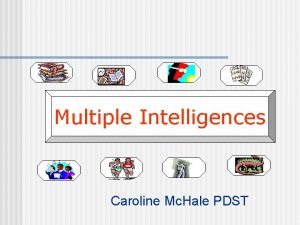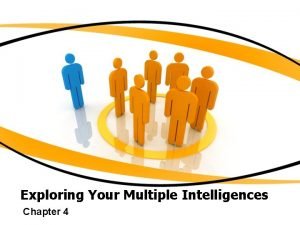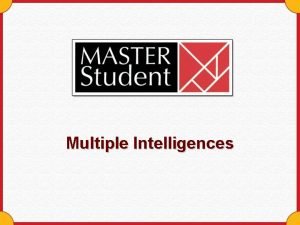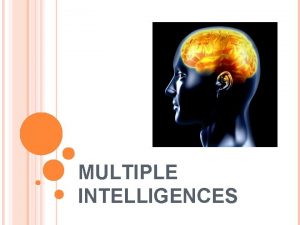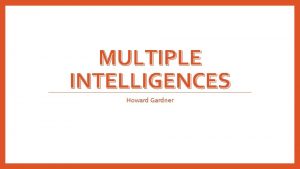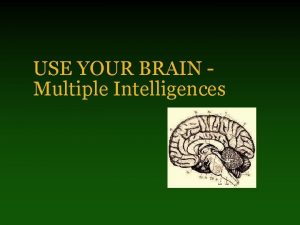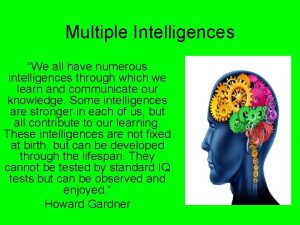TEACHING THROUGH MULTIPLE INTELLIGENCES Introduction to the Theory














- Slides: 14

TEACHING THROUGH MULTIPLE INTELLIGENCES Introduction to the Theory of Multiple Intelligences (MI) Applying theory – examples of MI activities-: 1. Be Yourself, by Fritz Perls (from Seeds of Confidence, Veronica de Andres, Jane Arnold, Helbling Languages, 2009) 2. Vision of Danger (summary of the story from High Flyer Upper Intermediate, Student’s Book, Ana Acevedo, Marisol Gower, Longman, 1999) Kedves Blanka Colegiul Național Octavian Goga, Miercurea Ciuc

INTRODUCTION The theory of Multiple Intelligences proposed by dr. Howard Gardner puts forth the idea that each individual’s intelligence is composed of multiple intelligences. All humans are born with different sets of intelligences and are capable to process information in at least eight different ways; they tend to excel in one area over another. Appreciating diversity, recognizing individuality and applying this theory help children to identify their natural competences, gifts and cultivate those, to improve their learning, their self-esteem, self-motivation, independence, and to develop cross-curricular thinking skills that go beyond the classroom to become a positive force for improving their lives in general.

http: //schools. alcdsb. on. ca

KEY FEATURES OF THE MI THEORY 1. Each person possesses all eight intelligences. 2. Most people can develop each intelligence to an adequate level of competency. 3. Intelligences usually work together in complex ways. 4. There are many ways to be intelligent within each category.

3. MI Teaching Strategies; Techniques and Activities LINGUISTIC Lectures Presentations Discussions Debates Word games Writing Brainstorming LOGICAL Mystery /Pb. solving Classifying Socratic questioning Heuristics Inquiry into grammar Analogies Logic puzzles Crossword puzzle SPATIAL Color cues/symbols Graphs/charts/ diagrams/maps Drawings/Posters Comparing or describing pictures Cuisenaire rods Conducting experiment Videos /Computer use KINESTHETIC Hands-on activities Role plays Plays /Miming Charades Using gestures Running dictation Manipulating objects MUSICAL Mood music Songs /Singing Chants and Raps Topic related recorded musical selections Creating melodies INTERPERSONAL Pair-work Peer teaching Cooperative groupsgroup projects Team games Board games Group brainstorming Simulation NATURALIST Nature walks Field trips Ecology projects Nature videos Studying changes in the outside world/Eco study Nature topics INTRAPERSONAL Reflection moments Options for HW and assignments Opportunities for choices Setting goals Independent study Journal keeping

4. MI Assessment There are no standard tests to assess MI learning. MI assessment calls for multiple measures for each intelligence. Characteristics: MI assessments identify strengths, are meaningful for students, offer immediate feedback to them, use familiar materials, score on a range of problems in the context of problem-solving (are ecologically valid), and they are instructive for teachers. Examples of assessment (products): Linguistic: written test, essay, poem, interview, phone call, email exchange Logical: flow chart, calculation, experiment, concept map Musical: song, pop record, musical Kinesthetic: role-play, dance, puppet show, mime Spatial: piece of artwork, 3 D model, painting, video, mind map Interpersonal: contribution to group discussion, group presentation, team strategy Intrapersonal: diary, monologue Naturalist: any classification work, hierarchy, key

Practical activities: Activities using all intelligences – understanding a shared text: Linguistic: Logical: Musical: 1. Find 3 keywords in the 1. Count up the proper 1. Use a soundtrack or sounds that 1. Provide images/objects to text. nouns support the meanings of the text 2. Write down the 2. Use a Venn diagram to 2. Emphasize the rhythm in the text adjectives. represent the dialogues of text 2. Draw mind maps for the 3. Read the first paragraphs 2 and 4 3. Read the questions and answers text alternately 3. Make a flow chart of with the right intonation the text Spatial: support the meanings of the 3. Design a book cover for the story Interpersonal: Intrapersonal: Kinesthetic: Naturalist: 1. In pairs discuss about 1. Copy your favourite 1. Use finger movements or 1. Find the nature related the characters: 3 paragraph sounds to punctuate text words personality traits for each 2. Reflect on the text; 2. Move hands up and down to 2. Organize the first three 2. How do the characters identify yourself with one indicate intonation in one sentences into: verbs, nouns, feel in the end? of the characters paragraph adjectives, adverbs 3. Read a paragraph in 3. Write a personal 3. Make human tableaux to 3. Draw the landscape (first sync response to the text illustrate aspects of the text paragraph), write the names of plants.

Text 1: Be Yourself by Fritz Perls Be as you are And so see who you are And how you are Let go for a moment or two Of what you ought to do And discover what you do do Risk a little if you can Feel your own feelings Say your own words Think your own thoughts Be your own self Discover Let the plan for you Grow from within you

Tasks Be Yourself 1 1. Linguistic: Make a crossword puzzle, using the word or line you like Read the lines of the poem alternately 2. Logical: Find three words that appear most frequently Count the three letter words 3. Musical: Use a soundtrack (music/sounds) that supports the meanings of the text Make a short song with the favourite word/line 4. Visual: Provide images (pictures, drawings) that support the meanings of the poem Make a poster or design a logo for T-shirts, using words from the text Colour all “schwa” letters (replace them with the symbol Ə)

Be Yourself 2 5. Interpersonal: Read the text all together in sync Make and act a short play from the favourite line/word Discuss in groups what you mean by “be yourself”, give examples 6. Intrapersonal: Make your own copy of the poem Reflect alone on the lines; write down your thoughts, your personal response 7. Kinesthetic: Read and use body movements to show the meanings Move hands up and down to indicate intonation Make a pop-up card/book using words/lines from the poem 8. Naturalist: Organize the words into a hierarchy (verbs/nouns/etc. ; 1 -syll. /etc. ) Write the name of an animal/a plant beginning with the first letter of each line

Text 2: Vision of Danger Summary (1) EPISODE ONE It was a bright summer morning. Anya, with a strange feeling that it would be a special day, was walking on London’s crowded streets towards Piccadilly Circus. When she reached it, she suddenly saw a boy, about her age, sitting in a coach. Before she could say anything, the coach moved forward and disappeared in the traffic. EPISODE TWO Stefan, feeling that something was pulling him towards the city, was looking out of the coach window and when they stopped at a traffic light in Piccadilly Circus, he saw her. Then the coach moved. Stefan couldn’t concentrate on the visit to the Crown Jewels. When they were allowed to go their separate ways, he went to Primrose Hill Park knowing he had to go there. He met Anya. EPISODE THREE Anya and Stefan were talking about themselves and about their strange feelings, both knowing that had to happen, when Anya heard a song. They thought it was one of Stone’s songs, her favourite singer: “Orpheus, beware! There is danger in the air Your songs and voice are sweet But the dragon has come to eat. ” EPISODE FOUR Anya and Stefan met in the next few days, and one day Stefan came agitated. He tried to surprise Anya with that song, he went to Tower Records, but he found out that the record didn’t exist. They started to wonder why they heard it everywhere. They looked through some books of mythology and thought that Stone, like Orpheus, both being wonderful musicians, had to be in danger.

Vision of Danger Summary (2) EPISODE FIVE They managed to get Stone’s address from his agent’s file. It was a place in the middle of the country, almost invisible from the road, surrounded by thick, high walls, guarded by security men with fierce dogs. They didn’t let the two children enter. Anya and Stefan walked round the walls and started to climb up an oak tree, but the guards caught and threatened them. They ran away. EPISODE SIX The children were sad because nobody believed them, not even the police. They talked to Anya’s father, who made some notes about what Orpheus and the dragon might represent and told them that it might not be any connection between the poem and Stones. Then he gave them tickets to go to Stone’s concert the following night. EPISODE SEVEN Anya and Stefan went to Wembley Stadium to see Stone’s concert. Stone sang all his best songs. Halfway through the show, Stone wanted to make an announcement. Suddenly, Stefan got up and started to push his way towards the stage, shouting: “Stop him!” A man jump onto the stage with a gun in his hand fired. A body fell heavily to the floor. EPISODE EIGHT Stefan was lying on the stage, smiling and telling Anya: “we did it. ” Stone thanked Stefan, but the security men took the singer quickly off the stage. Stefan was taken to the hospital. Their story appeared in the papers. After recovering, Stefan left. Anya watched the plane disappear into the sky, knowing that they would never really be apart.

Tasks Vision of Danger Summary Linguistic: 1. Find 3 keywords in the text 2. Write down the adjectives 3. Read the first 3 paragraphs alternately Logical: 1. Count up the proper nouns in the text 2. Find the word that appears most frequently 3. Make a flow chart of the text Musical: 1. Use a soundtrack or sounds that support the meanings of the text 2. Make a short song/rap using the text 3. Read the song about Orpheus with the right intonation Spatial: 1. Make a logo for a T-shirt, using the text 2. Design a book cover for the story 3. Provide images to support the meanings of the text/ storyboard the text/ make a video Interpersonal: 1. In pairs discuss about the two main characters: 3 personality traits for each 2. How do the characters feel in each paragraph? 3. Read one paragraph in sync / make and act a short play using (parts of) the story Intrapersonal: 1. Copy your favorite paragraph 2. Write personal response to the text, your opinion about the story 3. Reflect on the text; identify yourself with one of the characters. Write your thoughts Kinesthetic: 1. Use finger movements or sounds to punctuate text (one of the paragraphs) 2. Make a pop-up card using words, expressions from the story 3. Make human tableaux to illustrate aspects of the text (3) Naturalist: 1. Find the nature related words 2. Organize the first paragraph into: verbs, nouns, adjectives. 3. Draw the landscape presented in the 2 nd or 5 th paragraph. Write names for plants/animals.

Bibliography � � � Armstrong, Thomas (2009) Multiple Intelligences in the Classroom. 3 rd edition. Alexandria, VA: ASCD Baum, Susan, Julie Viens, and Barbara Slatin, in consultation with Howard Gardner (2005) Multiple Intelligences in the Elementary Classroom, A Teacher’s Toolkit. New York: Teachers College Press Fleetham, Mike (2006) Multiple Intelligences in practice enhancing self-esteem and learning in the classroom. Stafford: Network Continuum Education Andrés, Verónica De and Jane Arnold (2009) Seeds of Confidence. London: Helbling Languages Acevedo, Ana and Marisol Gower (1999) High Flyer Upper Intermediate, Student’s Book, Longman
 Gardner learning styles
Gardner learning styles Edutopia multiple intelligences quiz
Edutopia multiple intelligences quiz Howard gardners theory of multiple intelligences
Howard gardners theory of multiple intelligences Multiple intelligences and differentiated instruction
Multiple intelligences and differentiated instruction Howard gardner ap psychology
Howard gardner ap psychology Bgfl multiple intelligence test
Bgfl multiple intelligence test Montessori for multiple intelligences
Montessori for multiple intelligences Gardner's multiple intelligences
Gardner's multiple intelligences Interpersonal intelligence?
Interpersonal intelligence? Multiple intelligences in the classroom
Multiple intelligences in the classroom Multiple intelligences
Multiple intelligences Leonardo da vinci spatial intelligence
Leonardo da vinci spatial intelligence Multiple intelligences test
Multiple intelligences test Gardners multiple intelligence test
Gardners multiple intelligence test Multiple intelligences musical
Multiple intelligences musical
